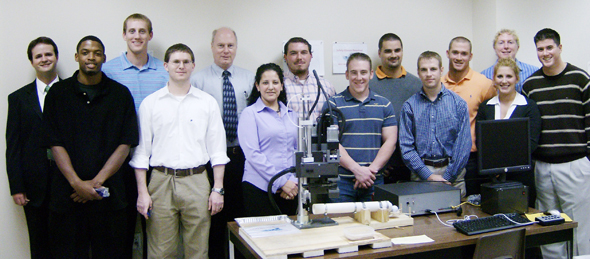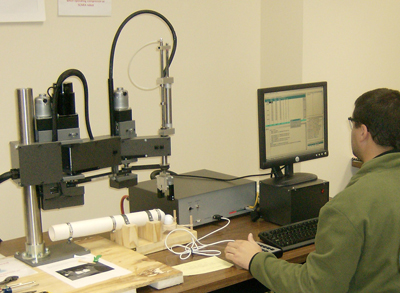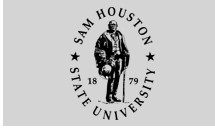Student Relationships With Robots Are Purely 'Platonic'
 |
| Gathered around the new SCARA robot
in the College of Business Administration's Sower Technology
Laboratory are, front row from left, Shamir McDaniel,
Jacob Parkins, Lupe Schneider, Kyle Klock, Daniel Hirsch,
Paige Dunlap and Wade Pate. Second row, from left, are
Michael Middlebrook, Ryan Griffin, Professor Sower, Brian
Pape, Timothy Cobb, Tyson Mire and Jason Farr. |
Business administration students at Sam Houston State University
are learning the newest uses of automated tracking devices
and industrial robots through a method as old as the philosophies
of Plato.
Some of the students have been extremely innovative, and even
programmed a robot to receive a bucket of golf balls and place
them one by one on a golf tee. While the golf ball exercise
may not sound useful, it was part of a learning process directed
by Vic Sower, professor of operations management in the College
of Business Administration.
Sower has won both the SHSU Excellence in Teaching (1996)
and Excellence in Research (2001) Awards as well as the Minnie
Stevens Piper Foundation Award (2005). He has been teaching
Sam Houston State students about the latest trends in automation
since 1993, when he acquired a robot known as a Mentor flexible
manufacturing cell.
 |
| Timothy Cobb at work on the new SCARA
robot. |
Even before that he was a big fan of Plato.
"It is not enough for students to simply have 'heard
about' an innovative concept," said Sower. "Plato's
four forms of awareness are imaging, perceptual belief, understanding
and insight, and to be truly prepared they must progress through
each step."
"Imaging" can come from textbooks, he explains.
"Perceptual beliefs" involves hands-on experience.
"Understanding" is the student connecting the classroom
and lab to the real world. "Insight" is creativity
and innovation, sometimes achieved as a student but sometimes
only later in a career.
While "flexible manufacturing" relates primarily
to technology, it is also a "philosophy." "Innovation,"
"agility," and "customer service" are
some of its characteristics.
The Mentor robot is used to study how an organization can
change design processes in reaction to customer needs. This
involves such areas as producing different parts without major
retooling, changing to production of new products, and rapidly
increasing or decreasing production.
The work Sower and his students did with Mentor won an award
for innovation in education from the Southwestern Business
Deans Association. It was also the subject of papers published
in the Journal of Management Education and presented at conferences
of the Israel Society for Quality and the APICS (operations
management) association.
A paper on this approach to teaching about the radio frequency
identification system was presented at a conference at Baylor
University last year and is being submitted for possible publication
in a management education journal.
The paper's authors include Pam Zelbst and Ken Green, both
associate professors of management at SHSU, and Sower.
Over the years Sower's students have gone into the work force
and done well with the training they received at Sam Houston
State. Now they are returning the favor.
When Sower began a project to upgrade Mentor and another "servo"
robot, to purchase a companion robot known as a SCARA and
equipment relating to radio frequency identification technology,
many responded with donations.
A total of $33,000 was raised, which also included funding
from the College of Business Administration and contributions
by Sower, Zelbst, and other SHSU faculty members and alumni.
The room in which the equipment is used was designated as
the Sower Technology Laboratory.
One of the new acquisitions was a $15,000 SCARA (Selective
Compliant Assembly Robot Arm). The SCARA is a "pick and
place" robot used in industry for applications such as
putting components on circuit boards, inserting items in packages,
painting automobiles and placing boxes on pallets.
The picking and placing golf ball exercise was done to document
the robot's accuracy and precision, but Sower jokes that he
is looking into its possible application at country clubs
and driving ranges.
Some believe that radio frequency identification will eventually
replace bar codes.
"Wal Mart, among other retailers, has recently mandated
that its top suppliers provide RFID tags on their merchandise,"
said Sower. "New passports will contain an RFID tag.
Some say that eventually we will have all of our medical information
on an RFID tag on a medical ID card."
Some SHSU students seem to have already reached Plato's "insight"
level.
One idea from a class taught by Zelbst last semester was to
use RFID chips in special education classrooms so that blind
students could use RFID scanners for identifying and describing
objects. Another, taken from the tragedy at Virginia Tech,
was to use RFID chips to allow building and classroom access
only to students registered for classes in a building at a
specific time.
"If Plato could come back and see what we're doing,"
Sower said, "I'm not sure what he would think of golf
balls or the SCARA robot. But I believe he would recognize
our educational method."
—END—
SHSU Media Contact: Frank
Krystyniak
Feb. 1, 2008
Please send comments, corrections, news tips to Today@Sam.edu.
|








